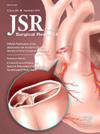Adjuvant Radioactive Iodine Ablation in Tall Cell Subtype Papillary Thyroid Cancer: A Systematic Review and Meta-analysis
IF 1.8
3区 医学
Q2 SURGERY
引用次数: 0
Abstract
Introduction
Tall cell subtype papillary thyroid cancer (TCS-PTC) is associated with aggressive disease features and worse patient outcomes. It remains unclear whether adjuvant radioactive iodine (RAI) ablation following thyroidectomy is associated with improved survival in TCS-PTC. The purpose of this review and meta-analysis was to determine whether adjuvant RAI was associated with improved survival in patients with TCS-PTC.
Methods
We included any study design that investigated survival outcomes in adult patients diagnosed with TCS-PTC who underwent either thyroidectomy following by adjuvant RAI or thyroidectomy alone. We searched MEDLINE, EMBASE, Scopus, and CENTRAL databases from inception with no restrictions. All screening and review stages were performed in duplicate. Risk of bias was evaluated using ROBINS-I and certainty of evidence were evaluated using GRADE. Meta-analysis was performed using a random effects model and we calculated pooled hazard ratios (HRs), where applicable. All analyses were performed in RevMan 5.3 (Cochrane, UK).
Results
Seven nonrandomized studies were included with 9611 TCS-PTC patients, of which 6296 (65.5%) underwent adjuvant RAI. All studies were at high risk of bias. Based on low certainty evidence, we found that adjuvant RAI was possibly associated with improved overall survival in TCS-PTC (HR = 0.60, 95% confidence interval: 0.42-0.85). This benefit was maintained in studies that performed propensity score matching, but we did not find a significant association with tumor size. Sensitivity analysis to remove studies with potentially overlapping data changed the HR to 0.74 (95% CI: 0.46-1.19) with considerable heterogeneity (I2 = 70%). Based on very low certainty evidence, we were uncertain where adjuvant RAI was associated with cancer-specific or recurrence-free survival.
Conclusions
Adjuvant RAI may be associated with improved overall survival in TCS-PTC, but future high-quality randomized studies with risk stratification are needed.
高细胞亚型甲状腺乳头状癌的放射性碘消融辅助治疗:系统回顾与元分析》。
导言:高细胞亚型甲状腺乳头状癌(TCS-PTC)具有侵袭性疾病特征,患者预后较差。目前仍不清楚甲状腺切除术后辅助放射性碘(RAI)消融是否与TCS-PTC生存率的提高有关。本综述和荟萃分析旨在确定辅助 RAI 是否与 TCS-PTC 患者生存率的提高有关:我们纳入了所有研究设计,这些设计调查了确诊为 TCS-PTC 的成年患者在接受甲状腺切除术后辅助 RAI 或单独接受甲状腺切除术的生存结果。我们对 MEDLINE、EMBASE、Scopus 和 CENTRAL 数据库进行了无限制检索。所有筛选和审查阶段均一式两份。使用 ROBINS-I 评估偏倚风险,使用 GRADE 评估证据的确定性。采用随机效应模型进行 Meta 分析,并酌情计算汇总危险比 (HR)。所有分析均在RevMan 5.3(Cochrane,英国)中进行:共纳入了 7 项非随机研究,9611 名 TCS-PTC 患者接受了 RAI 辅助治疗,其中 6296 人(65.5%)接受了 RAI 辅助治疗。所有研究均存在高偏倚风险。基于低确定性证据,我们发现辅助 RAI 可能与 TCS-PTC 总生存率的改善有关(HR = 0.60,95% 置信区间:0.42-0.85)。在进行倾向评分匹配的研究中,这种益处得以保持,但我们没有发现与肿瘤大小有显著关联。通过敏感性分析剔除数据可能重叠的研究后,HR 变为 0.74(95% 置信区间:0.46-1.19),异质性相当大(I2 = 70%)。基于确定性极低的证据,我们无法确定辅助 RAI 与癌症特异性生存或无复发生存的相关性:结论:RAI辅助治疗可能与TCS-PTC总生存率的改善有关,但未来还需要进行风险分层的高质量随机研究。
本文章由计算机程序翻译,如有差异,请以英文原文为准。
求助全文
约1分钟内获得全文
求助全文
来源期刊
CiteScore
3.90
自引率
4.50%
发文量
627
审稿时长
138 days
期刊介绍:
The Journal of Surgical Research: Clinical and Laboratory Investigation publishes original articles concerned with clinical and laboratory investigations relevant to surgical practice and teaching. The journal emphasizes reports of clinical investigations or fundamental research bearing directly on surgical management that will be of general interest to a broad range of surgeons and surgical researchers. The articles presented need not have been the products of surgeons or of surgical laboratories.
The Journal of Surgical Research also features review articles and special articles relating to educational, research, or social issues of interest to the academic surgical community.

 求助内容:
求助内容: 应助结果提醒方式:
应助结果提醒方式:


